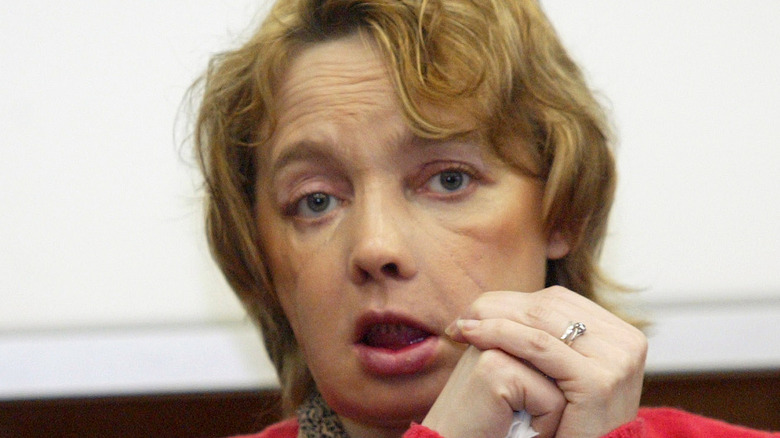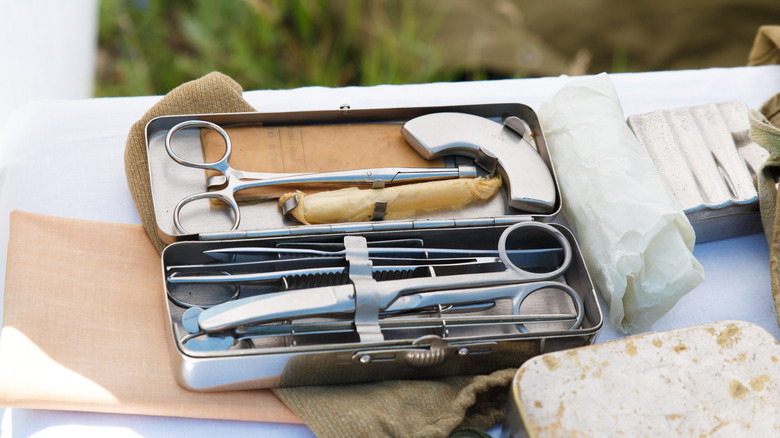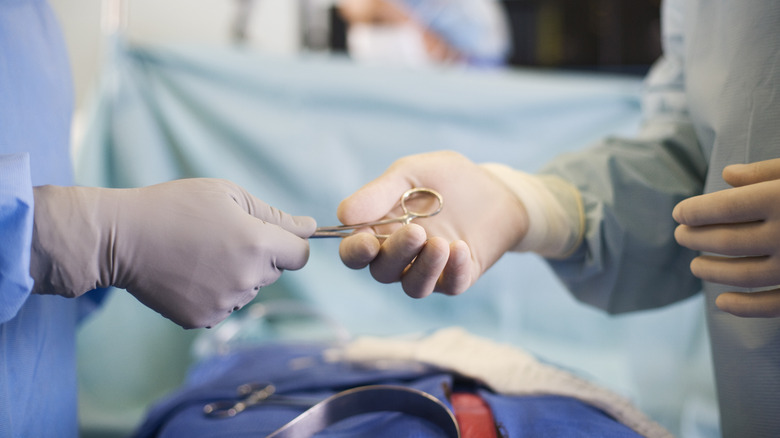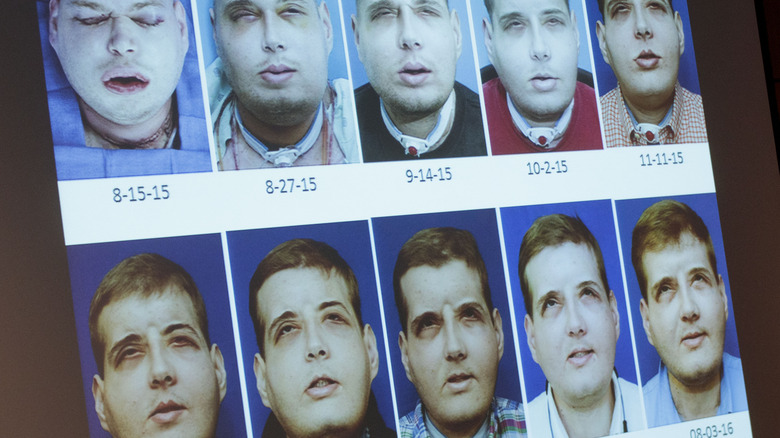The Tragic Story Of The World's First Face Transplant Recipient
In 2005, while experiencing depression, Isabelle Dinoire overdosed on sleeping pills and passed out (via the BBC). Although the pills did not kill Dinoire, the incident did land her in the hospital with horrific injuries. While she was out cold, Dinoire's pet dog destroyed a chunk of her face, leaving her skull exposed after chewing off her mouth and nose. Dinoire awoke surrounded by her own blood and only realized what had happened after she went to light a cigarette and could not hold it in her mouth (via The New York Times). She was left with what she referred to as "the face of a monster" (via The Guardian).
But Dinoire was offered an unexpected lifeline — a radical surgery that had never been attempted before. After French authorities granted them permission, French surgeons gave Dinoire a partial face transplant — the first in history. The surgery was groundbreaking and has been attempted many times since. However, the psychological impact of the experimental surgery would mark Dinoire for the rest of her life, and the effects of the medicines on Dinoire's body would eventually cause her death.
If you or someone you know needs help with mental health, please contact the Crisis Text Line by texting HOME to 741741, call the National Alliance on Mental Illness helpline at 1-800-950-NAMI (6264), or visit the National Institute of Mental Health website.
Facial reconstruction and face transplants
Plastic surgery, including facial reconstruction, has been around for centuries, but traditionally, a patient's own skin and tissue are used to rebuild damaged facial features. Skin grafts, for example, were invented thousands of years ago in ancient India. By World War I, the need for plastic surgery due to the use of modern weaponry led to major improvements in these types of procedures (via Royal Free London).
Fast forward to 1994, and the first face "replant" was attempted after a little girl in India got her hair caught in a threshing machine (via The Telegraph Online). Parts of the girl's face and scalp were successfully reattached to her head by a surgeon who took a gamble and attempted to reconnect the young girl's veins and nerves. By the early 2000s, ordinary skin grafts had become quite sophisticated, which has led many people to question why doctors carried out a face transplant on Isabelle Dinoire in the first place (via The New York Times). When doctors opted to use somebody else's face for the surgery, they ran a high risk that the body would reject the transplant. Dinoire was warned prior to the dangerous surgery that there was only a 33% chance it would actually work.
Dinoire's surgery
The face transplant procedure was carried out in a hurry with limited discussion due to doctors' fears about scarring should they delay (via The Guardian). According to the BBC, after just 15 hours, the operation was completed and deemed a success. When she caught sight of her new face in the mirror, Isabelle Dinoire, who was initially unable to speak, passed her doctors a note that simply said: "Merci" (via The New York Times).
After the operation, Dinoire looked almost normal, and she told reporters that she was hugely grateful for the surgery. She quickly gained control of the muscles in her new face, learning to eat and speak again after practicing in front of a mirror (via The Guardian). Dinoire later wrote about her experience of adjusting to life with a stranger's face in a memoir entitled "Isabelle's Kiss."
In the aftermath of the operation, some people voiced their concerns that the procedure was unethical, arguing that Dinoire was clearly psychologically unwell and was therefore not an ideal candidate. The doctors involved responded that Dinoire's case was so bad that it warranted radical treatment.
If you or someone you know needs help with mental health, please contact the Crisis Text Line by texting HOME to 741741, call the National Alliance on Mental Illness helpline at 1-800-950-NAMI (6264), or visit the National Institute of Mental Health website.
An unfamiliar face
The face transplant ultimately had some eerie consequences for the patient. Isabelle Dinoire reported that she initially felt deeply unsettled when looking at her own face in the mirror after the accident. From then on, she was perpetually doomed to see another person staring back at her.
"When I look in the mirror, I see a mixture of the two [of us]," she told the BBC. "The donor is always with me." She explained that she never got used to feeling her tongue inside another person's mouth (via The Guardian). The donor, like Dinoire, had also attempted suicide. After hanging herself, the woman was declared brain dead, and her family gave the hospital permission to use her face for Denoire's operation (via The Independent).
The surreal situation left Denoire with a profound sense of connection with the donor, a woman who had also experienced depression and who had unknowingly transformed her life for the better. Dinoire remarked in interviews that she thought about her frequently (via the BBC): "When I feel down, or depressed, I look at myself in the mirror again and think of her. And I tell myself, I'm not allowed to give up. She gives me hope."
If you or someone you know needs help with mental health, please contact the Crisis Text Line by texting HOME to 741741, call the National Alliance on Mental Illness helpline at 1-800-950-NAMI (6264), or visit the National Institute of Mental Health website.
If you or anyone you know is having suicidal thoughts, please call the National Suicide Prevention Lifeline by dialing 988 or by calling 1-800-273-TALK (8255).
Complications from the surgery
According to the Journal of the History of Medicine and Allied Sciences, news about Isabelle Dinoire's surgery was unexpectedly leaked by the British Press and led to a whirlwind of unwanted media publicity. She was laughed at by children in the street, and she received a great deal of unwanted attention that she struggled to deal with (via the BBC). Dinoire would eventually pull through and learn to accept her new face with courage, but she still had to deal with medical complications caused by the surgery and drugs she was put on.
She was subjected to endless rounds of immunosuppressant drugs and injections to prevent her body from rejecting the transplant (via NBC News). Following the surgery, Dinoire suffered from kidney failure and a number of infections, and she started to lose control of her lips in the lead-up to her death (via The Guardian). Ultimately, the impact of the immunosuppressants on her body caused Dinoire to contract two different forms of cancer. She died aged just 49 in 2016.
The hospital that performed Dinoire's surgery released a statement after her death in which they stated that even with the very best immuno-therapies, most patients suffer complications from skin transplants (via The New York Times).
The future of face transplants
The incredible difference Isabelle Dinoire's surgery made to her quality of life for a brief time has encouraged doctors to keep trying. Face transplants are still rare, but some progress has been made since Dinoire's surgery. The first full face transplant took place in 2010 in Barcelona, Spain. The patient had his jaw, cheekbones, nose, and even his eyelids replaced after shooting himself in the head (via The Guardian). The first American patient, Connie Culp, regained her ability to talk and smell in 2008 after being shot by her husband.
As of 2021, almost 50 face transplants have been attempted in total with varying degrees of success (via Healthline). Doctors often struggle to find appropriate donors for the surgery, which has impeded the progress of this still-young piece of medicine (Journal of the History of Medicine and Allied Sciences). For a transplant to work, donors must be of the same blood type, have a similar skin tone, and be of a similar age. Serious moral and clinical concerns about the surgery also continue to trouble doctors, but the miraculous benefits of the surgery give many hopes for a brighter future.





